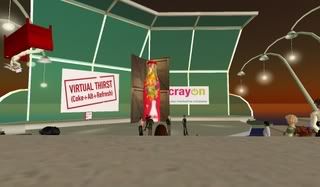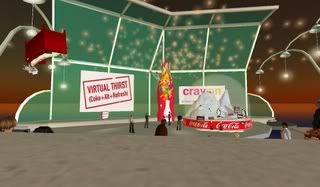
Over the last 3 months, some interesting developments have occurred in the area of advertising in video games, though most of them have simply left me with more questions to be answered in the months and years to come. I’ve noticed five major themes in my research so far. These are the problem of casual vs. hardcore games, the problem of making in-game advertising profitable, the emergence of several new methods of measurement, the growing importance of things like Second Life and advergaming, and the fact that new markets are being reached all the time. This industry is only getting started, and it’s pretty exciting to see how quickly things are changing.
The first major issue I noticed was the question of whether casual or hard core games were better suited for advertising. Often it was implied that the whole point of advertising in video games was to reach the extremely fragmented young male audience who can’t be reached through any other medium. By that logic, advertisers would have to use traditional big-budget games. It was said that these games created an emotional attachment that kept people involved and constantly coming back for more. However, I have consistently argued that there is little future for advertising here – there simply aren’t enough games that could support it and those that can have to be careful that they don’t make players angry. The Guitar Hero III example, where brands that had no place in the game managed to actually anger gamers, shows exactly what will keep happening unless some serious restructuring of the gaming industry is done. Casual gaming, on the other hand, is usually free, so people are more willing to put up with ads during their game play. And they’d more than likely be willing to put up with a few more if it meant keeping their games free. It targets a much wider audience, making it considerably more profitable, and there are a large variety of gaming sites to advertise on. I would predict that casual games will be the way of the future.
The second issue I kept running into was the frenzy surrounding the idea that in-game advertising was going to be a $1 billion industry by 2010. NBC Universal teamed up with IGA to begin producing in-game ads as part of multi-media packages. Microsoft bought Massive Inc last year. AOL is re-launching games.com to pick up on some of this ad revenue. User-generated gaming site mygame.com is all about upcoming game developers making advertising money. The first result I saw from all of this craziness was that sad result that is Guitar Hero III – so packed with ads and product placements that it actually disgusted several game reviewers, despite the fact that the game itself was great. I reiterate my opinion that ads will never really find a home in traditional video games. But what of casual gaming? This model seems to be working, but I’m still not sure if I can see it becoming a $1 billion industry in the next two years. Luckily, the CEO of EA recently agreed with me on that point.
The third major trend I saw was the beginning of ways to measure the effectiveness of video games as a medium. Neilson Media Research launched its Nielson GamePlay Metrics in July to measure PC and console video game usage. It gives the same kind of in-depth audience data provided for television, which is very useful information for advertisers – assuming they ever come. Another new development came when EmSense developed a way to use empirical data to read people’s emotional responses to games. They monitored everything from eye movements, heart rate and brainwaves, to how players furrow their eyebrows, blush and sweat. This allows game developers to get the best reaction possible from their games, and could allow advertisers to determine the best placement for their ads. With these developments coming within a year of each other, it seems to be a sign of the importance of video games to marketers in the years to come.
A trend I saw that I’m still not sure what to think about is Second Life. The virtual world does seem to have a relatively loyal following of about 400,000, and marketers are really making an effort to try to make it in the name of innovation. Expensive virtual islands are being bought, in-world billboards are being plastered around cities, and promotions that try to get people to interact with the brands are being tested. Crayon’s Coca-Cola Virtual Thirst Contest was really cool to watch, and I think it was a neat idea that did something to actually contribute to the game instead of just advertising at people. However, the residents of Second Life are not thrilled to see marketers in their space, and I’ve seen articles about residents actually voting to ban PR agencies from particular islands for not following their rules. I don’t see the virtual trend going away, but I’m curious to see how advertisers will be able to make it where they are not liked and seldom paid attention to.
I spent a good deal of time researching and talking about advergaming, because I am very curious to see which way that trend goes. The vast majority of it does not go past the extremely casual web-game found on advertisers’ own sites, or simple and poorly done banner ads that have you push a button a few times to win a prize. However, I saw real potential for this idea in the Burger King games, which get people involved and let them have a little fun without shoving the brand down their throats. Unfortunately, I don’t think a single good example of advergaming has come around since then. Toyota made a very sad attempt that didn’t seem totally thought through with their Xbox live game “Yaris”. They essentially made a game that was boring, had terrible controls, and only succeeded in making people angry, and then associating that anger with their brand. Over all, I would really like for advergaming to succeed, and to see more examples of good games that just happen to revolve around a brand. However, if the current trend of making a bad game just for the sake of being able to say they did continues, then that hope may be in vain.
The last issue that has come up a lot recently is the ability to come up with a consistent way to create revenue using in-game ads. There is no single “gaming audience”, there is no single channel that they all use, there is no consistency in the types of ads that exist in games, and there is no consistency in the way these ads are viewed. Specifically in the world of casual gaming, revenue can be generated by letting people play the whole game for free with a lot of supporting advertisements, or they can let people play the first level of a game for free and then make them pay. If this second method is used, then there is no room for advertising at all. Then there is always the games.com strategy of including product placement in their games, making people watch an ad before the game starts, and then littering the game play with interstitials. Depending on which business model prevails, advertisers may find themselves with nowhere to place their messages, and all the planning for the exponential growth of in-game ads could come to a screeching halt.
It will be very interesting to see which way the industry develops, and whether it ends up working out at all. Some very big claims have been made about the future of in-game advertising, but the industry’s success depends on whether or not it can find a market that will accept its presence, and games that are consistent with their brand message.







